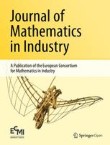Edited by: Giovanni Russo
The 18th European Conference on Mathematics for Industry, ECMI2014, was held in Taormina, Italy, in June 2014.
A record attendance was reached with more than 370 participants from all over the world. The book of proceedings is issued in two volumes for a total of more than 1100 pages, and is dedicated to the memory of Professor Angelo Marcello Anile, a distinguished scientist and applied mathematician deeply involved in industrial mathematics and with strong links to ECMI.
The conference covered mathematics in a wide range of applications and methods, from circuit and electromagnetic devices, to mathematical models and method for the environment, from mathematics in biology and medicine to finance. Great emphasis has been given to optimization and model order reduction, and to several other advanced mathematical and numerical tools which can be applied to a great variety of contexts. Special sessions have been dedicated to connections with industries, for example by the Eu-Maths-In network, and to education in mathematical modeling, two topics which are at the foundation of ECMI itself.
This Special Issue contains eleven selected papers based on work discussed at ECMI 2014, which reinforce the role of mathematics as being a catalyst for innovation as well as an overarching resource for industry and business.
Four papers deal with mathematical modeling and simulation of interest for the electronic industry, one of the main topics of the conference. In particular, papers by Causin & Malgaroli and Barletti concern the modelization of charge transport in graphene, a material that has attracted a great attention in the last decay. Bonille et al. deal with the use of a physical mechanism for the generation of a random sequences with potentially better properties than the classical pseudo-random sequences generated on the computer. Jan ter Maten et al. provide an interesting review paper on the nanoCOPS FP7 project, dealing with the problem of the relative influence of electrical, mechanical and thermal effects in integrated devices.
Two papers are of interest for applied material science. In particular, Micheletti et al. describe a mathematical model used to predict the geometry of inhomogeneity in dual phase steel, which in turn affects its mechanical properties. The model is realistically tuned by several 2D tomographic sections of the material. Cregan et al. deal with software sensing, a technique aimed at simulating the predicted quality of and industrial material from the elaboration of various sample measurements. The industrial application to the production of alumina is considered.
Two papers are devoted to applications to the environment, which was one to the five main themes of the conference. In particular, Sánchez-Linares et al. deal with the challenging problem of tsunami modeling. Advanced mathematical models, numerical methods and powerful computational tools implemented on racks of GPUs allow quite realistic simulation of the effects of tsunamis originated by strong quakes. The main problems is the uncertainly in the several parameters the mathematical models depend on. State-of-the art multilayer Monte-Carlo, coupled with advanced tsunami simulators, allow to perform a detailed uncertainly quantification, which is of utmost importance in the prediction of various scenarios of natural disasters related to tsunami formation and propagation. Coco et al. propose a new tool for the simulation of subsurface dynamics in volcanic areas, with concrete application and tests to the Campi Flegrei caldera in Italy.
The additional three papers are devoted to applications to food industry (Moroney et al.) biology and medicine (Causin & Malagoroli) and Finance (Teng et al.), the latter two being among the main themes of the conference. In particular, the work of Moroney et al. deals with modeling the extraction of solubles from coffee grains, Causin & Malgaroli concerns an important problem in ophthalmic pharmaceuticals, namely drug delivery to the posterior segment of the eye: several biological barriers have to be overcome, and the drug/dose ratio has to be optimized. The problem is tackled by a suitable mathematical model and appropriate numerical techniques, which allow to predict drug levels subsequent to transscleral drug implant.
The last paper, devoted to financial mathematics, deals with the mathematical modeling of stochastic correlation in finance, which may have relevant impact on pricing of financial derivatives.
